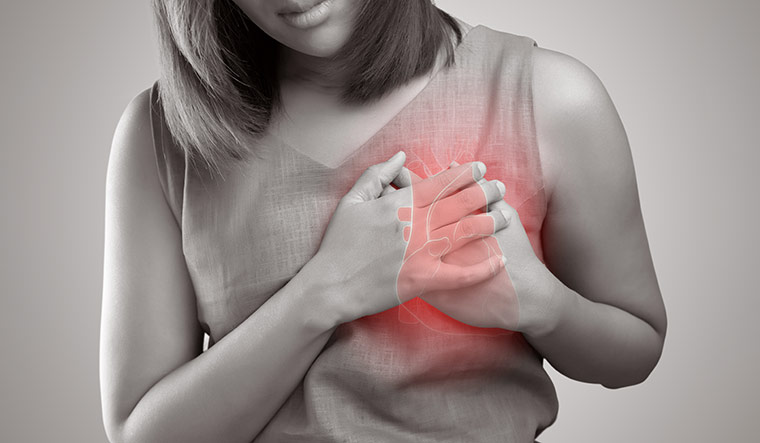There are diseases exclusive to women, like breast cancer and cervical cancer. But, it is still heart attacks that are responsible for the maximum number of deaths (among non-communicable diseases). Though hormones like oestrogen provide some protection, women still fare poorly when it comes to heart attacks.
This paradox stems from atypical and delayed presentation of heart attacks in women. It has been found that 10 to 40 per cent of female patients commonly have atypical to no symptoms during heart attacks. This leads to misdiagnosis and, as a result, lack of appropriate treatment and delay in delivering the right therapy.
While the heart of a man and a woman may look similar, there are significant differences. For example, a woman’s heart is usually smaller, as are some of its interior chambers. The walls that divide some of these chambers are thinner. And while a woman’s heart pumps faster than a man’s, it ejects about 10 per cent less blood with each squeeze. Hence, gender plays a role in the symptoms, treatment and outcomes of coronary disease.
When women experience stress, their pulse rate rises and heart ejects more blood. However in the case of men, the arteries constrict, causing a rise in blood pressure.
Noticeably, women tend to suffer from heart attacks at older age than men (average age for women is 70 and for men is 66). The protection offered by oestrogen is affected by menopause, when estrogen levels drop.
The most common symptoms of a heart attack is a compressive chest pain in the centre of the chest associated with radiation to the arms and neck, with profuse sweating. Awareness campaigns have lead to the faster recognition of these symptoms. Health care professionals are also educated on the options available for diagnosis and treatment, which has led to a vast utilisation of services like angioplasty. Primary angioplasty done within the first hour, called the golden hour, can result in a significantly better outcome both in terms of saving lives and also preserving the functional capacity of the affected heart.
For not completely known reasons, the female gender have shown lesser incidence of the typical presentation. They are less likely to have a central compressive chest pain. Often, they only have a vague discomfort, described by a few as fatigue that is of a sudden onset, and lasting from a few hours to days, without chest pain. Patients are fatigued even without exerting themselves. Few have a mild pain, localised to the upper abdomen or back, with nausea and sweating. Also seen are symptoms like a pain that starts in the chest and spreads to the back or pain in the lower left side of the jaw. Compared to men, women are more likely to have symptoms like palpitation, indigestion, weakness, nausea, breathlessness, dizziness, and back and neck pain; all in the absence of chest pain.
Most often the patients either do not go to the physicians for these complaints, or they are branded as suffering from acidity or stress-related issues. This significantly delays the suspicion of a possible cardiac etiology, which in turn delays the right treatment. Not only do the patients cross the golden hour, but they also suffer a large degree of heart muscle loss, which leaves them in a more vulnerable state ahead of procedures like angioplasty.
Here are a few risk factors that could potentially trigger heart attacks in women:
Diabetes: Frequent spiking in blood sugar damages the blood vessels and nerves. Yet the impact tends to be more visible among women than men.
Pregnancy complications: Diabetes and high blood pressure during pregnancy can increase the long-term risk of heart disease.
Gender-specific diseases: Conditions like polycystic ovary disease, endometriosis may also raise the risk of heart disease in women.
Pathophysiologically, the cause of deviation in the symptoms may be the underlying mechanism in which the blockage happens. Atypical ways of blood flow stoppages are more common in women. The most common mechanism is the deposition of a waxy substance inside the vessel leading to physical blockages. Though it is not gender specific, women develop a clot over the minor erosions on the surface of the vessel. This leads to partial obstruction of the vessel and causes the difference in the degree and location of pain. In a few cases, the vessel only goes for a transient spasm, only to re-open spontaneously. This leads to a short duration of symptoms, which keep recurring intermittently.
Preventive measures that can help in reducing the risk factors include avoiding tobacco, daily exercise, and a heart-healthy diet—low-fat dairy, lean meats, whole grains and plenty of fruits and vegetables. It is also important to manage stress and maintain healthy blood sugar and cholesterol levels. Devote time towards regular health screenings so that you may catch any anomalies or symptoms early on. Unlike the symptoms, treatment and medication for both men and women are similar. They go through stenting and angioplasty. Doctors recommend cardiac rehabilitation to improve health and aid recovery from heart disease.
Owing to the high incidence of atypical presentation in women, both physicians and patients need to have low threshold of suspicion for heart attacks, especially in those with risk factors like diabetes, hypertension, obesity, hypothyroidism, dyslipidemia or a family history of coronary artery disease.
Venkatraman is consultant interventional cardiologist, BGS Gleneagles Global Hospitals.




